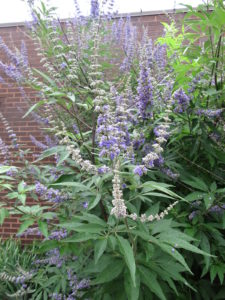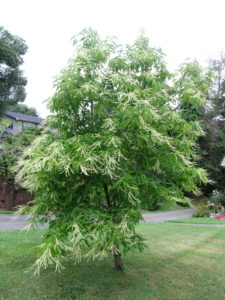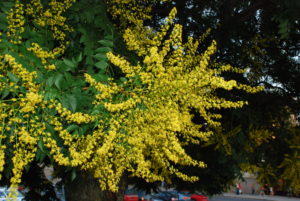Chaste Tree (Vitex agnus-castus) is a 10-15 feet tall, vase-shaped, deciduous shrub or a small 15-20 foot tree. The species is native from southern Europe and Asia. Often mistaken as a purple-flowering crapemyrtle, vitex is grown where wintry weather is not severe (USDA hardiness zones 6-9). Its palmately compound grayish-green leaves, composed of 5-7 lance-shaped leaflets, are aromatic if you rub. Airy panicles composed of tiny, fragrant, lavender to pale violet flowers (to 12″ long) appear in early to late summer. Blooms attract numerous bees and butterflies.
Sourwood (Oxydendrum arboreum), aka lily of the valley tree, is a deciduous understory tree that is native to the eastern U.S. from Pennsylvania south to Florida and Louisiana (USDA hardiness zones 5-9). A member of the Heath plant family, which includes azaleas, rhododendrons, and mountain laurels, plants prefer an acidic soil. This native tree (or multi-branched shrub) grows 20-25 feet tall (50 feet or more in the wild). Finely-toothed, 5-8 inch long, glossy green leaves produce one of showiest red fall hues. Terminal 4-8 inch long panicles of white lily-of-the-valley flowers drape off branch tips in early summer. Flowers are slightly fragrant. Long-lasting dried flower panicles are present through September, and attract many many bees and sourwood honey is a tasty result.
Goldenrain Tree (Koelreuteria paniculata) is a medium-sized, open-branched, deciduous tree with a rounded crown (USDA hardiness zones 5-9). Native to China, it grows 30-40 feet tall and almost as wide. Its pinnate or bipinnate compound leaves, up to 18 inches across, are comprised of 7-17 irregularly lobed leaflets. The bright green, blemish -free summer foliage turns yellow in fall. Bright yellow flowers (each 1/2 inch wide) appear in early July as part of terminal 12-15 inch panicles. Flowers give way to brown lantern-like, papery seed capsules in fall. Caution: many seedlings may arise and become troublesome.
General care recommendations: all three trees prefer a moisture, mildly acidic, well-drained soil and full sun. Sourwood prefers a more acidic pH soil. Vitex is best planted in sheltered sites in zones 6. In colder zone 5 winters, vitex can be grown as a 3-5 foot herbaceous flowering perennial. New compact vitex shrub forms are coming to garden centers.




 Posted in
Posted in 
